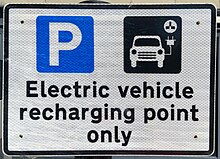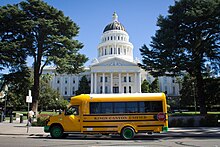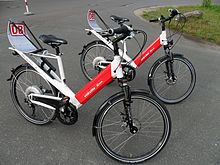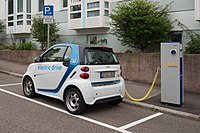Battery electric vehicle



Abattery electric vehicle(BEV),pure electric vehicle,only-electric vehicle,fully electric vehicleorall-electric vehicleis a type ofelectric vehicle(EV) that exclusively useschemical energystored inrechargeable batterypacks,with no secondary source of propulsion (a hydrogen fuel cell, internal combustion engine, etc.). BEVs useelectric motorsandmotor controllersinstead ofinternal combustion engines(ICEs) for propulsion. They derive all power from battery packs and thus have no internal combustion engine,fuel cell,orfuel tank.BEVs include – but are not limited to[1][2]– motorcycles, bicycles, scooters, skateboards, railcars, watercraft, forklifts, buses, trucks, and cars.
In 2016, there were 210 million electric bikes worldwide used daily.[3]Cumulative global sales of highway-capable light-duty pureelectric carvehicles passed the one million unit milestone in September 2016.[4]As of October 2020[update],the world's top selling all-electric car in history is theTesla Model 3,with an estimated 645,000 sales,[5]followed by theNissan Leafwith over 500,000 sales as of September 2020[update].[6]
History
[edit]During the 1880s,Gustave Trouvé,Thomas ParkerandAndreas Flockenbuilt experimental electric cars, but the first practical battery electric vehicles appeared during the 1890s.[7]Battery vehiclemilk floatsexpanded in 1931, and by 1967, gave Britain the largest electric vehicle fleet in the world.[citation needed]
Terminology
[edit]Hybrid electric vehiclesuse both electric motors and internal combustion engines, and are not considered pure or all-electric vehicles.[8]
Hybrid electric vehicles whose batteries can be charged externally are calledplug-in hybridelectric vehicles (PHEV) and run as BEVs during theircharge-depletingmode. PHEVs with aseriespowertrainare also called range-extended electric vehicles (REEVs), such as theChevrolet VoltandFisker Karma.
Plug-in electric vehicles(PEVs) are a subcategory ofelectric vehiclesthat includes battery electric vehicles (BEVs) and plug-in hybrid vehicles (PHEVs).
Theelectric vehicle conversionsof hybrid electric vehicles and conventionalinternal combustion enginevehicles (aka all-combustion vehicles) belong to one of the two categories.[8][9]
In China, plug-in electric vehicles, together with hybrid electric vehicles are called new energy vehicles (NEVs).[10]However, in the United States,neighborhood electric vehicles(NEVs) are battery electric vehicles that are legally limited to roads with posted speed limits no higher than 45 miles per hour (72 km/h), are usually built to have a top speed of 30 miles per hour (48 km/h), and have a maximum loaded weight of 3,000 pounds (1,400 kg).[11]
Vehicles by type
[edit]The concept of battery electric vehicles is to use chargedbatterieson board vehicles for propulsion. Battery electric cars are becoming more and more attractive with the higher oil prices and the advancement of new battery technology (lithium-ion) that have higher power andenergy density(i.e., greater possible acceleration and more range with fewer batteries).[12]Compared to older battery types such as lead-acid batteries.Lithium-ion batteriesfor example now have an energy density of 0.9–2.63 MJ/L whereas lead-acid batteries had an energy density of 0.36 MJ/L (so 2.5 to 7.3x higher). There is still a long way to go if comparing it to petroleum-based fuels and biofuels, however (gasoline having an energy density of 34.2 MJ/L -38x to 12.92x higher- and ethanol having an energy of 24 MJ/L -26x to 9.12x higher-). This is partially offset by higher conversion efficiency of electric motors – BEVs travel roughly 3x further than similar-size internal combustion vehicles per MJ of stored energy.
BEVs includeautomobiles,light trucks,andneighborhood electric vehicles.
Rail
[edit]- Battery electric railcars:

Battery electric trains in the form ofBEMUs(battery electric multiple units) are operated commercially inJapan.They are charged viapantographs,either when driving on electrified railway lines or during stops at specially equipped train stations. They use battery power for propulsion when driving on railway lines that are not electrified, and have successfully replaceddiesel multiple unitson some such lines.
Other countries have also tested or ordered such vehicles.
- Locomotives:
- Electric rail trolley:
Electric bus
[edit]
Chattanooga, Tennessee,operates ninezero-fareelectric buses, which have been in operation since 1992 and have carried 11.3 million passengers and covered a distance of 3,100,000 kilometres (1,900,000 mi). They were made locally by Advanced Vehicle Systems. Two of these buses were used for the1996 Summer Olympicsin Atlanta.[13][14]
Beginning in the summer of 2000,Hong Kong Airportbegan operating a 16-passengerMitsubishi Rosaelectric shuttle bus, and in the fall of 2000, New York City began testing a 66-passenger battery-poweredschool bus,an all-electric version of theBlue Bird TC/2000.[15]A similar bus was operated inNapa Valley, California,for 14 months ending in April 2004.[16]
The2008 Beijing Olympicsused a fleet of 50 electric buses, which have a range of 130 km (81 mi) with the air conditioning on. They uselithium-ion batteries,and consume about 1 kW⋅h/mi (0.62 kW⋅h/km; 2.2 MJ/km). The buses were designed by the Beijing Institute of Technology and built by the Jinghua Coach.[17]The batteries are replaced with fully charged ones at the recharging station to allow 24-hour operation of the buses.[18]
InFrance,the electric bus phenomenon is in development, but some buses are already operating in numerous cities.[19]PVI, a medium-sized company located in the Paris region, is one of the leaders of the market with its brandGepebus(offeringOreos 2XandOreos 4X).[20]
In theUnited States,the first battery-electric, fast-charge bus has been in operation inPomona, California,since September 2010 atFoothill Transit.TheProterraEcoRide BE35useslithium-titanate batteriesand is able to fast-charge in less than 10 minutes.[21]
In 2012, heavy-duty trucks and buses contributed 7% of global warming emissions in California.[22]
In 2014, the first production model all-electric school bus was delivered to the Kings Canyon Unified School District in California'sSan Joaquin Valley.The bus was one of four the district ordered. This battery-electric school bus, which has four sodium nickel batteries, is the first modern electric school bus approved for student transportation by any state.[23]
In 2016, including the light heavy-duty vehicles, there were roughly 1.5 million heavy-duty vehicles in California.[22]

The same technology is used to power the Mountain View Community Shuttles. This technology was supported by the California Energy Commission, and the shuttle program is being supported by Google.[24]
Thunder Sky
[edit]Thunder Sky (based in Hong Kong) buildslithium-ion batteriesused in submarines and has three models of electric buses, the 10/21 passenger EV-6700 with a range of 280 km (170 mi) under 20 mins quick-charge, the EV-2009 city buses, and the 43 passenger EV-2008 highway bus, which has a range of 300 km (190 mi) under quick-charge (20 mins to 80 percent), and 350 km (220 mi) under full charge (25 mins). The buses will also be built in the United States and Finland.[25]
Free Tindo
[edit]Tindo is an all-electric bus fromAdelaide, Australia.The Tindo (aboriginal word for sun) is made byDesignline International[26]inNew Zealandand gets its electricity from asolar PVsystem on Adelaide's centralbus station.Rides arezero-fareas part of Adelaide's public transport system.[27]
First Fast-Charge, Battery-Electric Transit Bus
[edit]Proterra's EcoRide BE35 transit bus, called the Ecoliner by Foothill Transit in West Covina, California, is a heavy-duty, fast charge, battery-electric bus. Proterra's ProDrive drive-system uses aUQMmotor and regenerative braking that captures 90 percent of the available energy and returns it to the TerraVolt energy storage system, which in turn increases the total distance the bus can drive by 31–35 percent. It can travel 30–40 miles (48–64 km) on a single charge, is up to 600 percent more fuel-efficient than a typical diesel or CNG bus, and produces 44 percent less carbon than CNG.[28]Proterra buses have had several problems, most notably in Philadelphia where the entire fleet was removed from service.[29]
Electric trucks
[edit]For most of the 20th century, the majority of the world's battery electric road vehicles were Britishmilk floats.[30]The 21st century saw the massive development ofBYDelectric trucks.[31]
Electric vans
[edit]In March 2012,Smith Electric Vehiclesannounced the release of the Newton Step-Van, an all-electric, zero-emission vehicle built on the versatile Newton platform that features a walk-in body produced by Indiana-basedUtilimaster.[32]
BYDsupplies DHL with electric distribution fleet of commercialBYD T3.[33]
Electric cars
[edit]A battery-poweredelectric caris anautomobilewhich ispropelledbyelectric motors.
Although electric cars often give good acceleration and have generally acceptable top speed, the lowerspecific energyof production batteries available in 2015 compared withcarbon-based fuelsmeans that electric cars need batteries that are a fairly large fraction of the vehicle mass but still often give a relatively low range between charges. Recharging can also take significant lengths of time. For journeys within a single battery charge, rather than long journeys, electric cars are practical forms of transportation and can be recharged overnight.
Electric cars can significantly reducecity pollutionby havingzero emissions.[34][35][36]Vehiclegreenhouse gassavings depend on how the electricity is generated.[37][38]
Electric cars are having a major impact in the auto industry[39][40]given advantages incity pollution,less dependence on oil and combustion, and scarcity and expected rise in gasoline prices.[41][42][43]World governments are pledging billions to fund development of electric vehicles and their components.[44][45]
Formula Eis a fully electric international single-seater championship. The series was conceived in 2012, and the inaugural championship started in Beijing on 13 September 2014. The series is sanctioned by the FIA. Alejandro Agag is the current CEO of Formula E.[46][47]
The Formula E championship is currently contested by ten teams with two drivers each (after the withdrawal of Team Trulli, there are temporarily only nine teams competing). Racing generally takes place on temporary city-center street circuits which are approximately 2 to 3.4 kilometres (1.2 to 2.1 mi) long. Currently, only the Mexico City ePrix takes place on a road course, a modified version of the Autódromo Hermanos Rodríguez.[citation needed]

Special-purpose vehicles
[edit]Special-purpose vehiclescome in a wide range of types, ranging from relatively common ones such asgolf carts,things likeelectric golf trolleys,milk floats,all-terrain vehicles,neighborhood electric vehicles,and a wide range of other devices. Certain manufacturers specialize in electric-powered "in plant" work machines.
Electric motorcycles, scooters and rickshaws
[edit]Three-wheeled vehicles includeelectric rickshaws,a powered variant of thecycle rickshaw.The large-scale adoption of electric two-wheelers can reduce traffic noise and road congestion but may necessitate adaptations of the existing urban infrastructure and safety regulations.[48]
Ather Energyfrom India has launched theirBLDC motorpoweredAther 450electric scooterwithLithium Ion batteriesin 2018.[49][50]Also from India, AVERA[51]– a new and renewable energy company is going to launch two models of electric scooters[52]at the end of 2018, withLithium Iron Phosphate Batterytechnology.[53][needs update]
Electric bicycles
[edit]

India is the world’s biggest market for bicycles at 22 million units per year. By 2024, electric two-wheelers will be a $2 billion market with over 3 million units being sold in India.[54]
The Indian government is launching schemes and incentives to promote the adoption of electric vehicles in the country, and is aiming to be a manufacturing hub for electric vehicles within the next five years.[55][56]
China has experienced an explosive growth of sales of non-assisted e-bikes including the scooter type, with annual sales jumping from 56,000 units in 1998 to over 21 million in 2008,[57]and reaching an estimated 120 million e-bikes on the road in early 2010. China is the world's leading manufacturer of e-bikes, with 22.2 million units produced in 2009.
Personal transporters
[edit]An increasing variety ofpersonal transportersare being manufactured, including the one-wheeledself-balancing unicycles,self-balancing scooters,electric kick scooters,andelectric skateboards.
Electric boats
[edit]Several battery electric ships operate throughout the world, some for business. Electricferriesare being operated and constructed.[58]
Technology
[edit]| Vehicle type | Fuel used |
|---|---|
| Combustion-only vehicle (ICE) |
Exclusively usespetroleumor other fuel. |
| Micro hybrid electric vehicle (μHEV) |
Exclusively uses petroleum or other fuel, but can shut off engine to consume less. |
| Mild hybrid electric vehicle (MHEV, BAHV) |
Exclusively uses petroleum or other fuel, but has electric battery to consume less. |
| Plug-in hybrid vehicle (PHEV) |
Uses mixture of petroleum or other fuel and electricity frompower grid. |
| All-electric vehicle (BEV, AEV) |
Exclusively uses electricity from power grid. |
| Fuel cell vehicle (FCV, FCEV) |
Exclusively useshydrogenor other fuel to generate electricity. |
Motor controllers
[edit]The motor controller receives a signal frompotentiometerslinked to the accelerator pedal, and it uses this signal to determine how much electric power is needed.[59]ThisDC poweris supplied by the battery pack, and the controller regulates the power to the motor, supplying either variable pulse width DC or variable frequency variable amplitude AC, depending on the motor type. The controller also handlesregenerative braking,whereby electrical power is gathered as the vehicle slows down and this power recharges the battery.[59]In addition to power and motor management, the controller performs various safety checks such as anomaly detection, functional safety tests and failure diagnostics.[60]
Battery pack
[edit]
Most electric vehicles today use anelectric battery,consisting ofelectrochemical cellswith external connections in order to provide power to the vehicle.[63]
Battery technology for EVs has developed from earlylead-acid batteriesused in the late 19th century to the 2010s, tolithium-ion batterieswhich are found in most EVs today.[60]The overall battery is referred to as abattery pack,which is a group of multiple battery modules and cells. For example, theTesla Model Sbattery pack has up to 7,104 cells, split into 16 modules with 6 groups of 74 cells in each. Each cell has a nominal voltage of 3–4volts,depending on its chemical composition.
Motors
[edit]Electric cars have traditionally used series wound DC motors, a form ofbrushed DC electric motor.Separately excited and permanent magnet are just two of the types of DC motors available. More recent electric vehicles have made use of a variety ofAC motortypes, as these are simpler to build and have no brushes that can wear out. These are usuallyinduction motorsorbrushless AC electric motorswhich use permanent magnets. There are several variations of the permanent magnet motor which offer simpler drive schemes and/or lower cost including thebrushless DC electric motor.
Once electric power is supplied to the motor (from the controller), the magnetic field interaction inside the motor will turn thedrive shaftand ultimately the vehicle's wheels.[59]
Economy
[edit]EV battery storage is a key element for the globalenergy transitionwhich is dependent on more electricity storage right now. As energy availability is the most important factor for the vitality of an economy the mobile storage infrastructure of EV batteries can be seen as one of the most meaningful infrastructure projects facilitating the energy transition to a fully sustainable economy based on renewables. A meta-study graphically showing the importance of electricity storage depicts the technology in context.[64]
Environmental impact
[edit]Power generation
[edit]Electric vehicles produce nogreenhouse gas (GHG) emissionsin operation, but the electricity used to power them may do so in its generation.[65]The two factors driving the emissions of battery electric vehicles are thecarbon intensityof the electricity used to recharge the Electric Vehicle (commonly expressed in grams of CO2per kWh) and the consumption of the specific vehicle (in kilometers/kWh).
The carbon intensity of electricity varies depending on the source of electricity where it is consumed. A country with a high share ofrenewable energyin its electricity mix will have a low C.I. In the European Union, in 2013, the carbon intensity had a strong geographic variability but in most of the member states, electric vehicles were "greener" than conventional ones. On average, electric cars saved 50–60% of CO2emissions compared to diesel and gasoline fuelled engines.[citation needed]
Moreover, the de-carbonisation process is constantly reducing the GHG emissions due to the use of electric vehicles. In the European Union, on average, between 2009 and 2013 there was a reduction in the electricity carbon intensity of 17%.[66]In alife-cycle assessmentperspective, considering the GHG necessary to build the battery and its end-of-life, the GHG savings are 10–13% lower.[67]
The open sourceVencoPymodel framework can be used to study the interactions between vehicles, owners, and the electricity system at large.[68]
Vehicle construction
[edit]GHGs are also emitted when the electric vehicle is being manufactured. The lithium-ion batteries used in the vehicle take more materials and energy to produce because of the extraction process of the lithium and cobalt essential to the battery.[69]This means the bigger the electric vehicle, the more carbon dioxide emitted. The same size-to-emission relationship applies to manufacturing of all products.
The mines that are used to produce the lithium and cobalt used in the battery are also creating problems for the environment, as fish are dying up to 240 km (150 mi) downstream from mining operations due to chemical leaks and the chemicals also leak into the water sources the people that live near the mines use, creating health problems for the animals and people that live nearby.[70]
See also
[edit]- All-electric range
- Automotive battery
- Battery balancing
- Capa vehicle
- Electric Drive Transportation Association(EDTA)
- Electric vehicle battery
- Electric vehicle warning sounds
- Global Electric Motorcars
- Government incentives for plug-in electric vehicles
- Greenpower
- Hydrogen vehicle
- List of electric cars currently available
- List of electric-vehicle-battery manufacturers
- List of production battery electric vehicles
- Miles per gallon gasoline equivalent
- Patent encumbrance of large automotive NiMH batteries
- Phase-out of fossil fuel vehicles
- Road-powered electric vehicle
- Short-commute vehicles
- Supercapacitor
- Think Global
- Tokyo Electric Power Company
- Wireless charging
- Personal electric vehicle(PEV)
References
[edit]- ^"FAQ".The Boring Company.Archived fromthe originalon 12 November 2020.Retrieved8 April2018.
- ^Goebel, Dan M; Katz, Ira (March 2008)."Fundamentals of Electric Propulsion: Ion and Hall Thrusters"(PDF).Jet Propulsion Laboratory,California Institute of Technology.Archived(PDF)from the original on 20 March 2009.Retrieved7 February2021.
literally hundreds of electric thrusters now operating in orbit on communications satellites, and ion and Hall thrusters both having been successfully used...
- ^"The State of the Electric Bicycle Market | Electric Bike Report | Electric Bike, Ebikes, Electric Bicycles, e Bike, Reviews".19 September 2016.
- ^Shahan, Zachary (22 November 2016)."1 Million Pure EVs Worldwide: EV Revolution Begins!".cleantechnica.com.Retrieved23 November2016.
- ^Kane, Mark (4 October 2020)."See The Best Selling Battery Electric Cars of All-Time Here".
- ^Kane, Mark (9 September 2020)."500,000th Nissan LEAF Was Produced In Sunderland, UK".InsideEVs.Retrieved18 November2020.
- ^Anderson, Curtis D.; Anderson, Judy (2010).Electric and Hybrid Cars: A History.McFarland. p. 22.ISBN9780786457427.
- ^abDavid B. Sandalow,ed. (2009).Plug-In Electric Vehicles: What Role for Washington?(1st. ed.). The Brookings Institution. pp. 2–5.ISBN978-0-8157-0305-1.See definition on pp. 2.
- ^"Plug-in Electric Vehicles (PEVs)".Center for Sustainable Energy, California. Archived fromthe originalon 20 June 2010.Retrieved31 March2010.
- ^PRTM Management Consultants (April 2011)."The China New Energy Vehicles Program – Challenges and Opportunities"(PDF).World Bank.Retrieved29 February2012.See Acronyms and Key Terms, pp. v
- ^"What is a neighborhood electric vehicle (NEV)?".AutoblogGreen. 6 February 2009.Retrieved9 June2010.
- ^"Battery Electric".4 Future Energy.com.Archived fromthe originalon 3 September 2009.Retrieved30 May2015.
- ^Downtown Electric ShuttleArchived13 September 2008 at theWayback Machine.Retrieved 18 August 2008.
- ^Success StoriesArchived20 May 2008 at theWayback Machine
- ^"Solectria Develops an All Electric Version of the Blue Bird TC2000".Archived fromthe originalon 4 December 2008.
- ^Electric School BusArchived30 September 2011 at theWayback Machine.Retrieved 18 August 2008.
- ^UNDP donates electric buses to Beijing Olympic Games.Retrieved 15 August 2008.
- ^"BIT Attends the Delivery Ceremony of the 2008 Olympic Games Alternative Fuel Vehicles with its Pure Electric Bus".Archived fromthe originalon 6 December 2008.
- ^"Bus et navettes électriques – Actualités en France et dans le monde".avem.fr.Archived fromthe originalon 20 July 2011.Retrieved29 July2011.
- ^"PVI, leader de la traction électrique pour véhicules industriels".Retrieved30 May2015.
- ^"Proterra Launches First Deployment of All-Electric, Zero-Emission Buses by Major Transit Agency".Archived fromthe originalon 30 August 2011.
- ^abChandler, Sara; Espino, Joel; O’Dea, Jimmy (2016). "Delivering Opportunity: How Electric Buses and Trucks Can Create Jobs and Improve Public Health in California". Union of Concerned Scientists.JSTORresrep17234.
{{cite journal}}:Cite journal requires|journal=(help) - ^"New All-Electric School Bus Saves California District $10,000+ Per Year".CleanTechnica.5 March 2014.Retrieved1 March2016.
- ^"Electric shuttle buses come to Mountain View, thanks to Motiv and Google".Silicon Valley Business Journal.13 January 2015.Retrieved30 May2015.
- ^"Lôi thiên ôn tư đốn điện trì hữu hạn công tư".Archived fromthe originalon 8 May 2015.Retrieved30 May2015.
- ^Posner, Andrew (19 December 2007)."When The Sun Shines Down Under...It Powers a Bus".TreeHugger.Retrieved11 March2012.
- ^"All-Electric, Solar-Powered, Free Bus!!!".Archived fromthe originalon 8 September 2009.
- ^"Proterra., Inc".Archived fromthe originalon 30 August 2011.Retrieved24 October2011.
- ^admin (21 September 2020)."Proterra electric buses taken out of service in Philadelphia".The Fourth Revolution.Retrieved15 October2020.
- ^"Escaping Lock-in: the Case of the Electric Vehicle".Cgl.uwaterloo.ca. Archived fromthe originalon 23 September 2015.Retrieved27 November2010.
- ^"byd-to-build-electric-trucks-in-ontario".Autotrader.ca. 15 November 2017.Retrieved15 November2017.
- ^smithelectric.com (5 March 2012)."Smith Electric Vehicle Launches Production of All-Electric Newton Step Van".smithelectric.com.Retrieved5 March2012.
- ^bydeurope.com (15 January 2016)."BYD supplies DHL with electric distribution fleet".bydeurope.com. Archived fromthe originalon 19 July 2018.Retrieved15 January2016.
- ^"Should Pollution Factor into Electric Car Rollout Plans?".Earth2tech.com. 17 March 2010.Archivedfrom the original on 24 March 2010.Retrieved18 April2010.
- ^"Electro Automotive: FAQ on Electric Car Efficiency & Pollution".Electroauto.com. Archived fromthe originalon 1 March 2009.Retrieved18 April2010.
- ^"Clean Air Initiative".Archived fromthe originalon 14 September 2016.Retrieved30 May2015.
- ^Notter, Dominic A.; Kouravelou, Katerina; Karachalios, Theodoros; Daletou, Maria K.; Haberland, Nara Tudela (2015). "Life cycle assessment of PEM FC applications: electric mobility and μ-CHP".Energy & Environmental Science.8(7): 1969–1985.doi:10.1039/c5ee01082a.
- ^Notter, Dominic A.; Gauch, Marcel; Widmer, Rolf; Wäger, Patrick; Stamp, Anna; Zah, Rainer; Althaus, Hans-Jörg (1 September 2010)."Contribution of Li-Ion Batteries to the Environmental Impact of Electric Vehicles".Environmental Science & Technology.44(17): 6550–6556.Bibcode:2010EnST...44.6550N.doi:10.1021/es903729a.ISSN0013-936X.PMID20695466.
- ^"Ford says auto future hinges on electric car | freep.com | Detroit Free Press".freep.com. Archived fromthe originalon 21 April 2010.Retrieved18 April2010.
- ^Martin LaMonica (2 February 2009)."Plotting the long road to one million electric cars".CNN.com.Retrieved18 April2010.
- ^Terry Macalister (11 April 2010)."US military warns oil output may dip causing massive shortages by 2015 | Business".The Guardian.London.Archivedfrom the original on 15 April 2010.Retrieved18 April2010.
- ^Macalister, Terry (7 February 2010)."Branson warns of oil crunch within five years | Business".The Guardian.London.Archivedfrom the original on 16 April 2010.Retrieved18 April2010.
- ^Loveday, Eric (8 June 2010)."ALG predicts gas at $4.13 by 2013; residual values for compacts, hybrids to climb – Autoblog Green".Green.autoblog.com.Archivedfrom the original on 14 August 2010.Retrieved16 July2010.
- ^"Obama pushes electric cars, battery power this week".USA Today.14 July 2010.
- ^"Freidman OpEd: China's 'Moon Shot' Versus America's".Archived fromthe originalon 3 November 2010.
- ^"Alejandro Agag CEO of Formula E Holdings LTD"(PDF).FiA.Retrieved6 August2022.
- ^"Alejandro Agag, Formula E Founder and Chairman, named Autocar's Motorsport Hero".FIA Formula E.8 June 2021.
- ^Weiss M; Dekker P; Moro A; Scholz H; Martin P (2015)."On the electrification of road transportation – A review of the environmental, economic, and social performance of electric two-wheelers".Transportation Research Part D.41:348–366.Bibcode:2015TRPD...41..348W.doi:10.1016/j.trd.2015.09.007.PMC7108350.PMID32288595.
- ^Ghoshal, Maria Thomas, Devjyot (5 June 2018)."The launch of this e-scooter is a moment of reckoning for India's EV market".Quartz India.Retrieved28 January2020.
{{cite web}}:CS1 maint: multiple names: authors list (link) - ^"Ather Energy showcases S340, 'India's first smart scooter' at Surge 2016".Tech2.25 February 2016.Retrieved28 January2020.
- ^"AVERA Electric Vehicles".AVERA.Retrieved19 September2018.
- ^Varma, P. Sujatha (13 April 2018)."AVERA News on The Hindu".The Hindu.Retrieved14 April2018.
- ^Varma, P. Sujatha (7 October 2017)."City-based firm to launch e-bikes in New Year".The Hindu.Retrieved8 October2017.
- ^"Electric Two-Wheeler and EV Revolution in India".BLive EV Store.29 December 2020. Archived fromthe originalon 19 January 2021.Retrieved23 July2022.
- ^"India plans $4.6 billion in incentives for battery makers in electric vehicle push: Document".The Economic Times.Retrieved12 March2021.
- ^"GNCTD EV".ev.delhi.gov.in.Retrieved12 March2021.
- ^Chi-Jen Yang (2010)."Launching strategy for electric vehicles: Lessons from China and Taiwan"(PDF).Technological Forecasting and Social Change(77): 831–834. Archived fromthe original(PDF)on 31 March 2010.
- ^"Batterifergen har måttet stå over avganger. Nå er løsningen klar".Teknisk Ukeblad.18 November 2016.Retrieved19 November2016.
- ^abc"How Exactly Do Electric Cars Work?".Green Car Future.11 November 2018.Retrieved22 November2018.
- ^ab"Components and Systems for Electric Vehicles (HEVs/EVs)".Hitachi Review.Retrieved22 November2018.
- ^Ziegler, Micah S.; Trancik, Jessika E. (2021)."Re-examining rates of lithium-ion battery technology improvement and cost decline".Energy & Environmental Science.14(4): 1635–1651.arXiv:2007.13920.doi:10.1039/D0EE02681F.ISSN1754-5692.S2CID220830992.
- ^"The price of batteries has declined by 97% in the last three decades".Our World in Data.Retrieved26 April2022.
- ^ Crompton, T. R. (20 March 2000).Battery Reference Book(third ed.). Newnes. p. Glossary 3.ISBN978-0080499956.Retrieved18 March2016.
- ^"Global electricity scenario and Electric vehicles"(PDF).prototype-creation.de.Retrieved23 April2020.
- ^Union of Concerned Scientists(November 2015)."Cleaner cars from cradle to grave: how electric cars beat gasoline cars on lifetime global warming emissions"(PDF).Archived(PDF)from the original on 22 November 2015.Retrieved7 February2021.
- ^Moro A; Lonza L (2018)."Electricity carbon intensity in European Member States: Impacts on GHG emissions of electric vehicles".Transportation Research Part D.64:5–14.Bibcode:2018TRPD...64....5M.doi:10.1016/j.trd.2017.07.012.PMC6358150.PMID30740029.
- ^Moro A; Helmers E (2017)."A new hybrid method for reducing the gap between WTW and LCA in the carbon footprint assessment of electric vehicles".The International Journal of Life Cycle Assessment.22(1): 4–14.Bibcode:2017IJLCA..22....4M.doi:10.1007/s11367-015-0954-z.
- ^ Wulff, Niklas; Miorelli, Fabia; Gils, Hans Christian; Jochem, Patrick (July 2021)."Vehicle Energy Consumption in Python (VencoPy): presenting and demonstrating an open-source tool to calculate electric vehicle charging flexibility".Energies.14(14): 4349.doi:10.3390/en14144349.ISSN1996-1073.Retrieved8 November2021.
- ^"Cleaner Cars from Cradle to Grave (2015)".Union of Concerned Scientists.Retrieved3 December2018.
- ^Katwala, Amit."The spiralling environmental cost of our lithium battery addiction".Retrieved3 December2018.
Further reading
[edit]- Witkin, Jim.Building Better Batteries for Electric Cars,The New York Times,31 March 2011, p. F4. Published online 30 March 2011. Discussesrechargeable batteriesand the new-technologylithium ion battery.
External links
[edit]- Patents
- U.S. patent 523,354,Emil E. Keller,Electrically Propelled Perambulator[dead link],1894
- U.S. patent 594,805,Hiram Percy Maxim,Motor vehicle,1897
- U.S. patent 772,571,Hiram Percy Maximet al.,Electric motor vehicle[dead link],1904
- Organizations
- Battery Vehicle Society (UK)
- Zap-Map – the UK national directory of recharging points.
- The European Association for Battery, Hybrid and Fuel Cell Electric Vehicles (AVERE).
- Czech EV Club – (CZ) Eng. section in photogallery.
- Alternative Technology Association Electric Vehicle Interest Group.
- Australian Electric Vehicle Association.
- Electric Car Society.
- News
- Reasons to buy an electric car in 2013
- AeroVironment Awarded U.S. Patent For Electric Vehicle Energy Data Management And Control(Green Car Congress)
- Solar charging station for Ford Focus Electric Vehicle
- Studies
- "Application of Life-Cycle Assessment to Nanoscale Technology: Lithium-ion Batteries for Electric Vehicles"(PDF).U.S. Environmental Protection Agency. 13 April 2013. Archived fromthe original(PDF)on 2 December 2013.Retrieved3 April2018.
- "Hybrid and Electric Vehicles – The Electric Drive Gains Traction"(PDF).International Energy Agency (IEA). May 2013. Archived fromthe original(PDF)on 26 February 2021.Retrieved3 April2018.
- Lee, Henry; Lovellette, Grant (July 2011)."Will Electric Cars Transform the U.S. Vehicle Market?"(PDF).Belfer Center for Science and International Affairs, Harvard University. Archived fromthe original(PDF)on 1 August 2011.Retrieved3 April2018.


